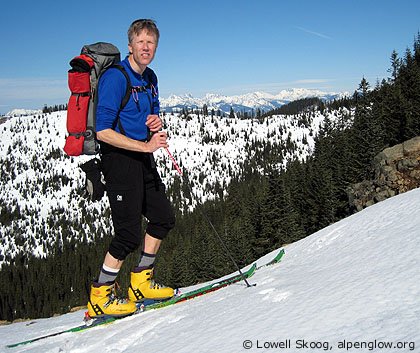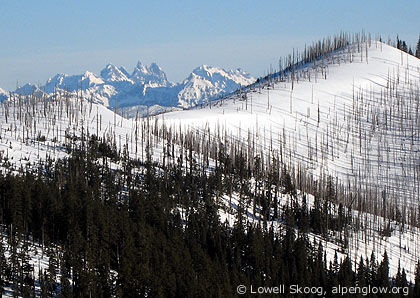

|
| The 15th Infantry ski patrol at Snoqualmie Pass, February 1941. Photo by John Woodward. Denver Public Library, Western History Collection. (Map, 500kb) |
|
Today the Cascade Crest between Snoqualmie Pass and Naches Pass is heavily logged and roaded. But it was not always so. In the 1930s and 1940s, few roads traversed the crest and logging was minimal. Old burns were more common than clearcuts. The Mountaineers located their Meany Ski Hut near Stampede Pass in the late 1920s because it offered "open slope skiing" in clearings created by forest fires. The crest between Snoqualmie Pass and Stampede Pass was well known before World War II, thanks to the Mountaineers Patrol Race, which ran from 1930 through 1941. By 1941, World War II was ravaging Europe and many Americans concluded that U.S. involvement in the war was inevitable. That winter, the War Department created six experimental ski patrols in army divisions across the northernern U.S. The patrols were ordered to test equipment and train their men in winter survival and skiing. If the experiment proved successful, the Army was considering a larger force that would be prepared to fight in the Alps or other mountainous terrain, should it become necessary.
In Washington state, ski patrols were established in the 41st Division at Spokane and the 3rd Division (15th Infantry Regiment) at Tacoma's Fort Lewis. Both patrols trained on Mount Rainier during the winter of 1940-41. In February, 1941, the 15th Infantry patrol capped off their training with a one-week ski traverse from Snoqualmie Pass to Naches Pass, a distance of about 55 miles. Leading the patrol were Capt. Paul Lafferty and Lt. John Woodward, both experienced mountaineers and skiers. The unit started at Snoqualmie Pass and followed the Mountaineers Patrol Race route (map, 400kb) to Stampede Pass. Lafferty was using a pair of prototype skis that were so stiff that they wouldn't float in the soft snow. After miles of trail breaking with a 65-pound pack, he developed painful shin splints that forced him to quit at Stampede Pass. He turned over command of the unit to Woodward, who guided them along the baffling crest, which was heavily forested and had many branches. They carried early topographic maps but it was easy to stray from the main divide onto spur ridges. After a week of travel, sleeping on snow in World War I vintage "shelter halves," the patrol skied down the road from Naches Pass toward Greenwater where they were met by army trucks. In a 2001 interview, John Woodward recalled how lucky he and Lafferty felt to be assigned to the 15th Infantry ski patrol. "Paul Lafferty and I used to feel kind of guilty," Woodward said, "because we were doing what we liked so much that we thought, 'Gosh, this is duty?' After we made the trip down the crest of the Cascades, a lot of my friends said 'Boy we've been talking about doing that for years and now you get the Army to pay you to do it. That's a dirty trick.'" Thanks in part to the success of the 15th Infantry ski patrol, the War Department created the 87th Mountain Infantry Regiment at Fort Lewis the following autumn. The 87th evolved into the legendary 10th Mountain Division, which fought heroically in Italy in 1945. After the war, the men of the 10th Mountain Division helped transform skiing and mountaineering in America.
When I decided to try to complete the Cascade Crest on skis during the winter of 2007, the segment from Stampede Pass to Naches Pass was my first priority. Since the 1980s, this portion of the Cascade Crest has been heavily logged. Much of the terrain is low in elevation, extensively roaded, and only skiable in mid-winter. None of my usual ski partners expressed any interest in this section of the crest, so I planned this as a solo trip. After studying the map, I decided to go from south to north, opposite the direction taken by the 15th Infantry ski patrol. The trip would begin at the Pyramid Creek sno-park, about 10 miles east of Greenwater, off Highway 410. It would end at the Crystal Springs sno-park near I-90, east of Snoqualmie Pass, a distance of 32 miles. Fortunately, my wife agreed to pick me up at Crystal Springs and drive me back to my car at Pyramid Creek, solving my logistical problems (see map, 500kb). I left Seattle at 3 a.m. on Saturday, February 17, and was underway from Pyramid Creek by headlamp around 5 a.m. Due to heavy snowmobile traffic and a long dry spell, Forest Service Road 70 near the sno-park had been transformed into an oily slab of ice. I walked a mile or two. Eventually the snow on the road improved and I skinned and skated to the foot of Pyramid Peak, reaching the top by 9 a.m.
The seven-mile section from Pyramid Peak to Blowout Mountain is the best part of the trip. The route stays near the true crest, between the Naches and Green River drainages, and it is the easiest way to go. I don't know exactly where the 15th Infantry went on their route, but they must have followed this section. North of Blowout Mountain, I deliberately followed logging roads to simplify route finding. I expected the roads to be well traveled by snowmobiles, but was surprised to find no recent tracks for nearly 15 miles, from Pyramid Peak to Tacoma Pass. Without the good spring-like snow conditions I had, the trail breaking would have been exhausting. From Tacoma Pass, I took a shortcut, following the Crystal Springs snowmobile trail system directly to The Mountaineers Meany Lodge. A "purist" route would have dog-legged west along the Cascade Crest to Snowshoe Butte. But I didn't feel compelled to be a purist. My progress was fast enough that I could have reached Meany that evening, but since I was tired and hadn't made reservations at the Lodge, I camped at Cabin Creek Saturday night. I reached Meany in a couple hours on Sunday morning, after a night of rain and snow in my tent. My trip went quickly, but I covered considerably less distance than the 15th Infantry did in 1941, since they started at Snoqualmie Pass. I had the benefit of lightweight equipment, modern topo maps, and a network of roads to follow. My trip really can't be compared to the achievement of John Woodward and his men. In their honor, I think the name "15th Infantry" should forever be associated with this section of the Cascade Crest. --Lowell Skoog
|
||||||||||||||||||||||||||||
|
Previous | Next | Overview - Skiing the Cascade Crest | The Alpenglow Gallery |



